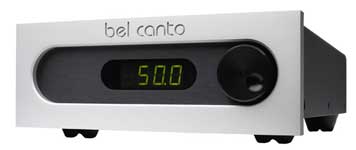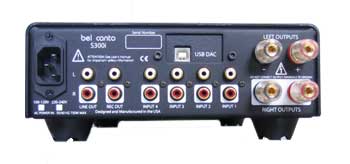| This song bird is not only cute but can hold a tune |
Bel Canto’s S300I is proof that Class-D designs
have matured
by Ernie Fisher
 Bel Canto is Italian and loosely translates to Beautiful
Singing, and, as you will see when you read the following,
there is evidence that the component under review is capable
of reproducing just that. Bel Canto has been in business
for over 10 years and is headed by John Stronzer. Their earlier
components included some vacuum tube designs, but the amp
under review is a noteworthy example of the relatively new
development of Class-D, or more precisely, a switching amplifier
design. This technology has evolved tremendously, and whereas
it was mostly used to power subwoofers, quite a few serious
manufacturers felt that it has certain advantages over Class-A
and AB topologies. Class-D guarantees high power efficiency
without energy losses encountered by standard designs. It
is known that the (theoretical) efficiency of Class-D designs
is 100%, though over 90% is more realistic in audio applications.
When compared to the efficiency of Class-B designs, which
ranges around 50%, a switching amp uses less operating power
while it delivers plenty of output power Bel Canto is Italian and loosely translates to Beautiful
Singing, and, as you will see when you read the following,
there is evidence that the component under review is capable
of reproducing just that. Bel Canto has been in business
for over 10 years and is headed by John Stronzer. Their earlier
components included some vacuum tube designs, but the amp
under review is a noteworthy example of the relatively new
development of Class-D, or more precisely, a switching amplifier
design. This technology has evolved tremendously, and whereas
it was mostly used to power subwoofers, quite a few serious
manufacturers felt that it has certain advantages over Class-A
and AB topologies. Class-D guarantees high power efficiency
without energy losses encountered by standard designs. It
is known that the (theoretical) efficiency of Class-D designs
is 100%, though over 90% is more realistic in audio applications.
When compared to the efficiency of Class-B designs, which
ranges around 50%, a switching amp uses less operating power
while it delivers plenty of output power
Appearance
If you are looking for a large, massive component, the BelCanto
is not for you. However, if you are looking to enhance a
listening room’s decor without clutter and favor an
uncomplicated system setup, the S300I fits very well. A large
window holds all display options and with only one large
knob on the unit’s right one can access input, volume
and balance controls. A remote control is included and allows
operation of the amplifier and BelCanto’s CD player.
The chassis is made of aluminum, which wraps around the component
resulting in an elegant, modern design that will harmonize
with or complement any décor.
The Sound
For most of the listening tests I used the new Argentum
cables (speaker and interconnects) and was happy with the
results. However, I was curious to find out what a medium
priced system will do when my in-house Ethera Vitae speakers
are connected with a $39,000K cable — Siltech’s
Emperor Crown. Well, the Siltech converted a medium-priced,
very good-sounding system to high-end, proving (again) that
cables can make a tremendous improvement to an existing component
combination. The only words to describe this completely out
of proportion set-up are astounding, amazing, extraordinary,
but not altogether surprising. However, the more realistic
set-up with the Argentum cables connected, rendered a very
musical system combination, better suited than with my in-house
medium-priced BIS Audio cables. Digital audio is often criticized
for hard sounding characteristics and lack of harmonics,
and I have auditioned (but not reviewed) a few of these designs.
I did, however, run across some excellent examples (which
I have reviewed) that showed no harmonic or musical restrictions,
and the Bel Canto tops the list. As a rule, I conduct a series
of listening test to determine the presence or absence of
harmonics and I found that the amp faithfully reproduced
the timbre and tonal inflections of various piano recordings.
Thus, I clearly heard the characteristics of a Yamaha grand
on a Three Blind Mice CD, the melodic tone of a Baldwin played
by Brubeck and the sophisticated sound of a Steinway grand
played by Gene Harris.
High frequencies didn’t abuse my sensitive ears with
strident harshness — something I somewhat expected — and
culminated with ease. Midrange, from about 150 to 1400Hz,
was outstanding with faultless transition into the lower
and higher frequency segments. This translates to appropriate
tonal equilibrium that allows inner detail to emerge, but
not dominate.
 Bass, all of it below 160 Hz to zero (if it were possible)
is the best I have ever heard on any amplifier. Solid, resolute,
full-bodied and harmonious are word that barely begin to
describe what this amp can do at bottom frequencies. All
in all, I feel that the S300i is a great little amplifier — cute
too. Bass, all of it below 160 Hz to zero (if it were possible)
is the best I have ever heard on any amplifier. Solid, resolute,
full-bodied and harmonious are word that barely begin to
describe what this amp can do at bottom frequencies. All
in all, I feel that the S300i is a great little amplifier — cute
too.
Synopsis
Even though some prominent high-end manufacturers have ventured
into digital audio technology, many analogue devotees still
frown upon anything digital. I think that this is unfair,
since, as all other technologies, tremendous advances have
been made. I feel that Bel Canto’s S300I is proof that
Class-D designs have matured and match conventional or classic
amp technology in all but the price. It is inexpensive and
provides oodles of power — usually more than one gets
with conventional amp technology. The S300i sounds great,
the musical information is on par with many higher priced
components; its size and handsome design makes it a perfect
fit with (almost) any décor, and it will handle a
great variety of loudspeakers. I recommend the use of premium
speaker cables and interconnects and found the Argentum cables
a perfect match without overspending. Though any good CD
player will do as a source component, I recommend Bel Canto’s
CD-2 (the matching player) as a great choice without spending
a bundle.
Commentary
High-end audio is often a psychoneurotic obsession with
perfection as seen and understood by audio enthusiasts. Small
imperfections are not tolerated and modifications, additions
and tweaks are as common as a change of the oil filter in
the car. Unfortunately, the reproduction of music for entertainment
and enjoyment — the very purpose for having an audio
system — is frequently forgotten as bias, misinformation
or preconceived beliefs prevent facts to emerge. The S300I
may not qualify as high-end, but it certainly is a delightful
component. I see the Bel Canto amplifier as an unpretentious
audio component that delivers plenty of entertainment, the
kind that makes you want to sit back and enjoy the music — and
that’s what it’s all about! |
| MODELS |
MANUFACTURER |
| S300I Integrated Dual Mono Amplifier |
Bel Canto |
| RATING |
CONTACT |
♪♪♪♪
|
Evolution
266 Applewood Cres
Vaughan, ON
T: 416-603-9090
www.evolutionhomecorp.com |
| PRICE |
$2,599.00 (CDN)
|
| Dimensions |
8.5” W x 12.5” D x 3” H (216
mm x 318 mm x 75 mm)
Weight: 12lbs. (5.5 kg)
|
|
 |
TECHNOLOGY
Class-D topology is based in switching output devices between
on and off conditions. In the “on” state, current
flows through the device (usually MOSFETs) while, though
hypothetically, without voltage from drain to source. In
the “off” state, voltage is present, but without
current flow and acts like an open-circuit.
The prevalent modulation methodology used in Class-D designs
is known as PWM (Pulse Width Modulation), which is a square
wave that has a fixed frequency. However, its top and bottom
position deviate as it follows the incoming signal. Hence,
when the input signal increases, the top position will be
present for longer than the bottom state, and vice-versa
when the signal is the high state. It’s complicated
stuff, but all we need to know is that Class-D, when done
correctly — that is with premium component selection
and precise PCB design — the results can be as good
as any competent traditional amplifier design.
Well, the S300i is one of the switching amplifiers that I
would rate as delightfully musical. The switching component
is Bel Canto’s own design, resulting in an amplifier
that delivers150W/channel into an 8 ohm load and 300W/channel
into 4 ohms. It seems that it doesn’t like to “see” less
than 4 ohms although it will handle loudspeakers that dip
lower occasionally (a lot of speakers do, of course).
Frequency Response is stable from 20Hz to 20kHz at +/- 0.5dB
(a great spec); total harmonic distortion is 0.01% at 1W,
1Khz with a 4 ohm load; intermodulation distortion is quoted
as 0.002%, 1W, 14:15KHz, 4 ohms. Output noise is 90uV A-weighted
from 20Hz-20KHz; voltage gain is 27dB; damping factor is >1000;
output Impedance is < 8 milliohms; dynamic range is 111dB;
input voltage for maximal output is 9.5 V RMS; input impedance
(RCA) is 10Kohms.
Two pairs of 5-way binding posts allow connecting speakers
with all terminations (my preference are banana plugs). Standby
power consumption is a mere 15 Watts. |
|
